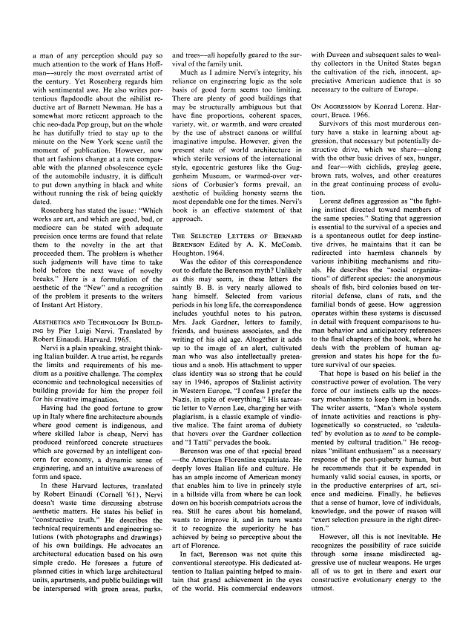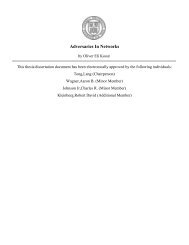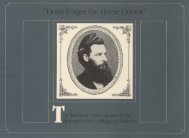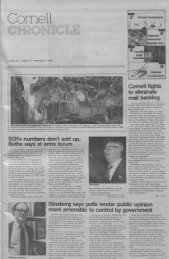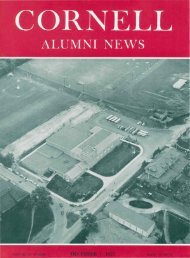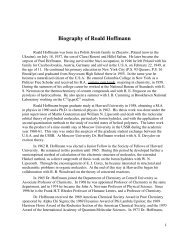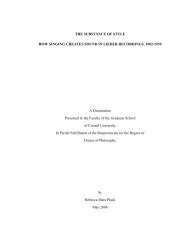Cornell Alumni News - eCommons@Cornell - Cornell University
Cornell Alumni News - eCommons@Cornell - Cornell University
Cornell Alumni News - eCommons@Cornell - Cornell University
Create successful ePaper yourself
Turn your PDF publications into a flip-book with our unique Google optimized e-Paper software.
a man of any perception should pay so<br />
much attention to the work of Hans Hoffman—surely<br />
the most overrated artist of<br />
the century. Yet Rosenberg regards him<br />
with sentimental awe. He also writes portentious<br />
flapdoodle about the nihilist reductive<br />
art of Barnett Newman. He has a<br />
somewhat more reticent approach to the<br />
chic neo-dada Pop group, but on the whole<br />
he has dutifully tried to stay up to the<br />
minute on the New York scene until the<br />
moment of publication. However, now<br />
that art fashions change at a rate comparable<br />
with the planned obsolescence cycle<br />
of the automobile industry, it is difficult<br />
to put down anything in black and white<br />
without running the risk of being quickly<br />
dated.<br />
Rosenberg has stated the issue: "Which<br />
works are art, and which are good, bad, or<br />
mediocre can be stated with adequate<br />
precision once terms are found that relate<br />
them to the novelty in the art that<br />
proceeded them. The problem is whether<br />
such judgments will have time to take<br />
hold before the next wave of novelty<br />
breaks." Here is a formulation of the<br />
aesthetic of the "New" and a recognition<br />
of the problem it presents to the writers<br />
of Instant Art History.<br />
AESTHETICS AND TECHNOLOGY IN BUILD-<br />
ING by Pier Luigi Nervi. Translated by<br />
Robert Einaudi. Harvard. 1965.<br />
Nervi is a plain speaking, straight thinking<br />
Italian builder. A true artist, he regards<br />
the limits and requirements of his medium<br />
as a positive challenge. The complex<br />
economic and technological necessities of<br />
building provide for him the proper foil<br />
for his creative imagination.<br />
Having had the good fortune to grow<br />
up in Italy where fine architecture abounds<br />
where good cement is indigenous, and<br />
where skilled labor is cheap, Nervi has<br />
produced reinforced concrete structures<br />
which are governed by an intelligent concern<br />
for economy, a dynamic sense of<br />
engineering, and an intuitive awareness of<br />
form and space.<br />
In these Harvard lectures, translated<br />
by Robert Einaudi (<strong>Cornell</strong> '61), Nervi<br />
doesn't waste time discussing abstruse<br />
aesthetic matters. He states his belief in<br />
"constructive truth." He describes the<br />
technical requirements and engineering solutions<br />
(with photographs and drawings)<br />
of his own buildings. He advocates an<br />
architectural education based on his own<br />
simple credo. He foresees a future of<br />
planned cities in which large architectural<br />
units, apartments, and public buildings will<br />
be interspersed with green areas, parks,<br />
and trees—all hopefully geared to the survival<br />
of the family unit.<br />
Much as I admire Nervi's integrity, his<br />
reliance on engineering logic as the sole<br />
basis of good form seems too limiting.<br />
There are plenty of good buildings that<br />
may be structurally ambiguous but that<br />
have fine proportions, coherent spaces,<br />
variety, wit, or warmth, and were created<br />
by the use of abstract canons or willful<br />
imaginative impulse. However, given the<br />
present state of world architecture in<br />
which sterile versions of the international<br />
style, egocentric gestures like the Guggenheim<br />
Museum, or warmed-over versions<br />
of Corbusier's forms prevail, an<br />
aesthetic of building honesty seems the<br />
most dependable one for the times. Nervi's<br />
book is an effective statement of that<br />
approach.<br />
THE SELECTED LETTERS OF BERNARD<br />
BERENSON Edited by A. K. McComb.<br />
Houghton. 1964.<br />
Was the editor of this correspondence<br />
out to deflate the Berenson myth? Unlikely<br />
as this may seem, in these letters the<br />
saintly B. B. is very nearly allowed to<br />
hang himself. Selected from various<br />
periods in his long life, the correspondence<br />
includes youthful notes to his patron,<br />
Mrs. Jack Gardner, letters to family,<br />
friends, and business associates, and the<br />
writing of his old age. Altogether it adds<br />
up to the image of an alert, cultivated<br />
man who was also intellectually pretentious<br />
and a snob. His attachment to upper<br />
class identity was so strong that he could<br />
say in 1946, apropos of Stalinist activity<br />
in Western Europe, "I confess I prefer the<br />
Nazis, in spite of everything." His sarcastic<br />
letter to Vernon Lee, charging her with<br />
plagiarism, is a classic example of vindictive<br />
malice. The faint aroma of dubiety<br />
that hovers over the Gardner collection<br />
and "I Tatti" pervades the book.<br />
Berenson was one of that special breed<br />
—the American Florentine expatriate. He<br />
deeply loves Italian life and culture. He<br />
has an ample income of American money<br />
that enables him to live in princely style<br />
in a hillside villa from where he can look<br />
down on his boorish compatriots across the<br />
sea. Still he cares about his homeland,<br />
wants to improve it, and in turn wants<br />
it to recognize the superiority he has<br />
achieved by being so perceptive about the<br />
art of Florence.<br />
In fact, Berenson was not quite this<br />
conventional stereotype. His dedicated attention<br />
to Italian painting helped to maintain<br />
that grand achievement in the eyes<br />
of the world. His commercial endeavors<br />
with Duveen and subsequent sales to wealthy<br />
collectors in the United States began<br />
the cultivation of the rich, innocent, appreciative<br />
American audience that is so<br />
necessary to the culture of Europe.<br />
ON AGGRESSION by Konrad Lorenz. Harcourt,<br />
Brace. 1966.<br />
Survivors of this most murderous century<br />
have a stake in learning about aggression,<br />
that necessary but potentially destructive<br />
drive, which we share—along<br />
with the other basic drives of sex, hunger,<br />
and fear—with cichlids, greyleg geese,<br />
brown rats, wolves, and other creatures<br />
in the great continuing process of evolution.<br />
Lorenz defines aggression as "the fighting<br />
instinct directed toward members of<br />
the same species." Stating that aggression<br />
is essential to the survival of a species and<br />
is a spontaneous outlet for deep instinctive<br />
drives, he maintains that it can be<br />
redirected into harmless channels by<br />
various inhibiting mechanisms and rituals.<br />
He describes the "social organizations"<br />
of different species: the anonymous<br />
shoals of fish, bird colonies based on territorial<br />
defense, clans of rats, and the<br />
familial bonds of geese. How aggression<br />
operates within these systems is discussed<br />
in detail with frequent comparisons to human<br />
behavior and anticipatory references<br />
to the final chapters of the book, where he<br />
deals with the problem of human aggression<br />
and states his hope for the future<br />
survival of our species.<br />
That hope is based on his belief in the<br />
constructive power of evolution. The very<br />
force of our instincts calls up the necessary<br />
mechanisms to keep them in bounds.<br />
The writer asserts, "Man's whole system<br />
of innate activities and reactions is phylogenetically<br />
so constructed, so 'calculated'<br />
by evolution as to need to be complemented<br />
by cultural tradition." He recognizes<br />
"militant enthusiasm" as a necessary<br />
response of the post-puberty human, but<br />
he recommends that it be expended in<br />
humanly valid social causes, in sports, or<br />
in the productive enterprises of art, science<br />
and medicine. Finally, he believes<br />
that a sense of humor, love of individuals,<br />
knowledge, and the power of reason will<br />
"exert selection pressure in the right direction."<br />
However, all this is not inevitable. He<br />
recognizes the possibility of race suicide<br />
through some insane misdirected aggressive<br />
use of nuclear weapons. He urges<br />
all of us to get in there and exert our<br />
constructive evolutionary energy to the<br />
utmost.


